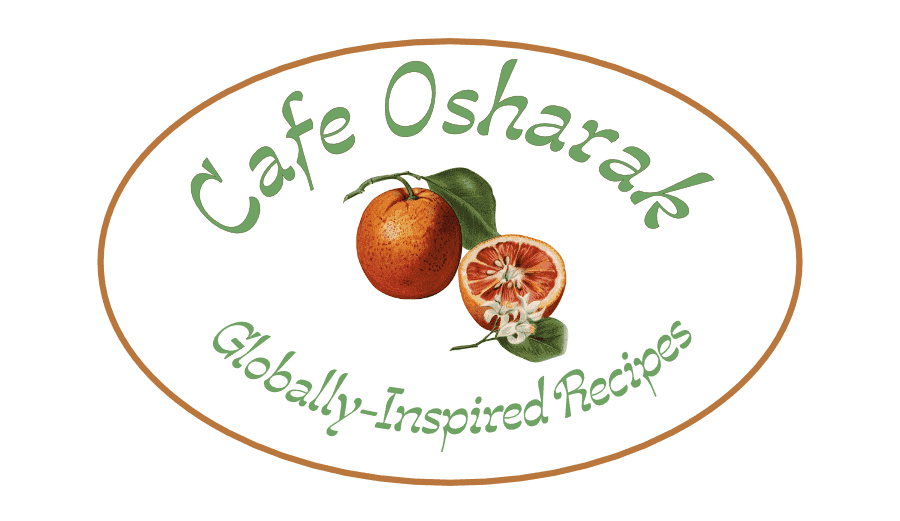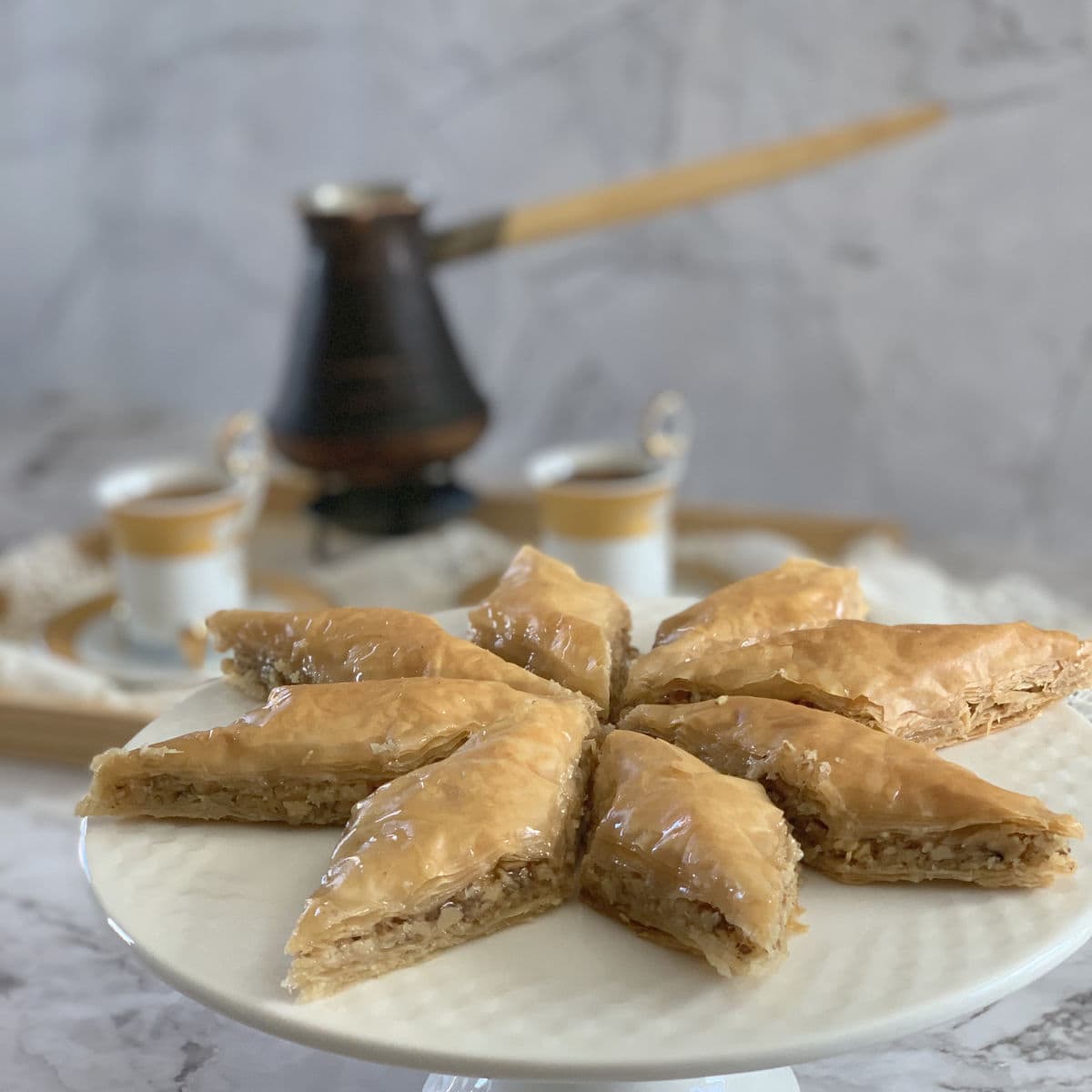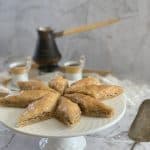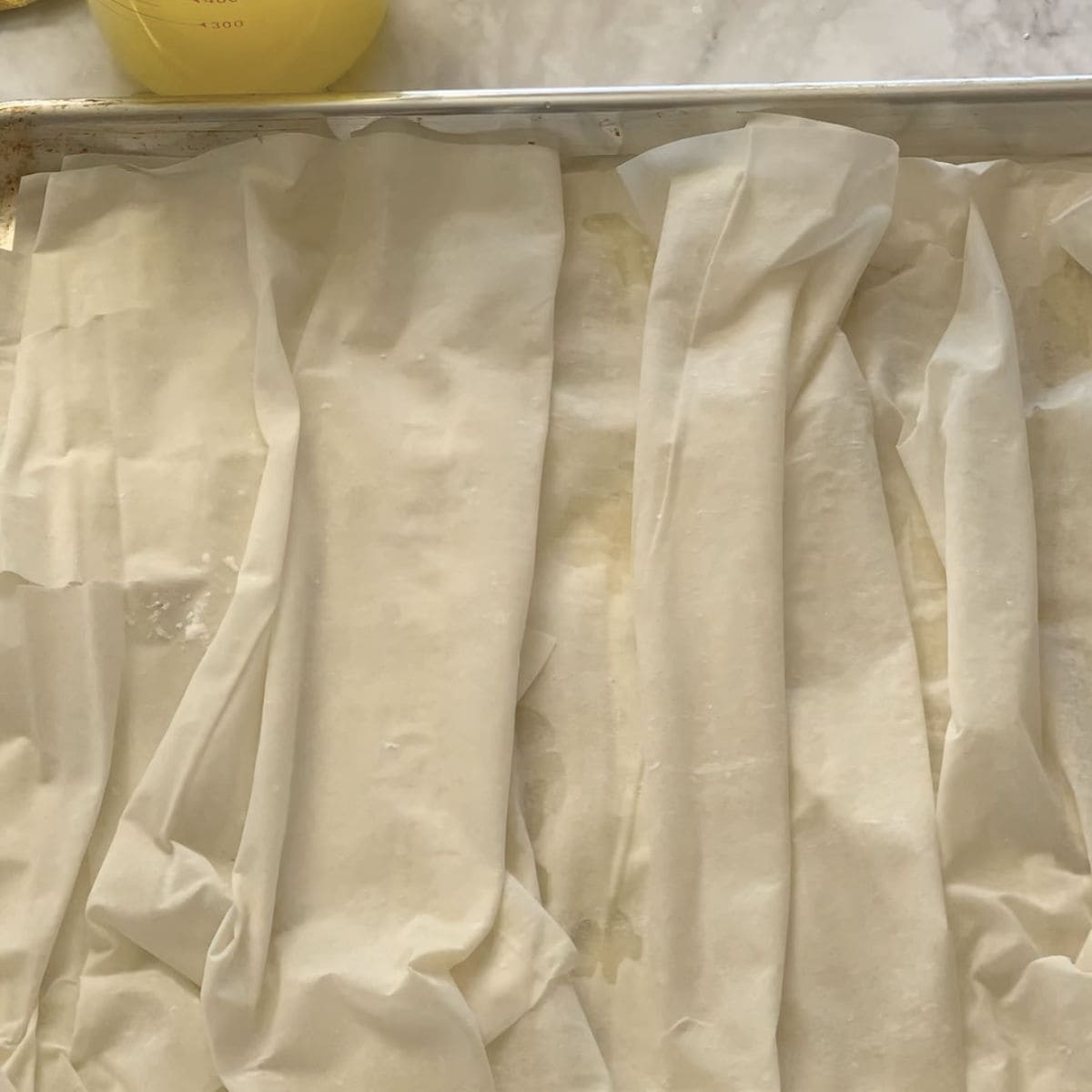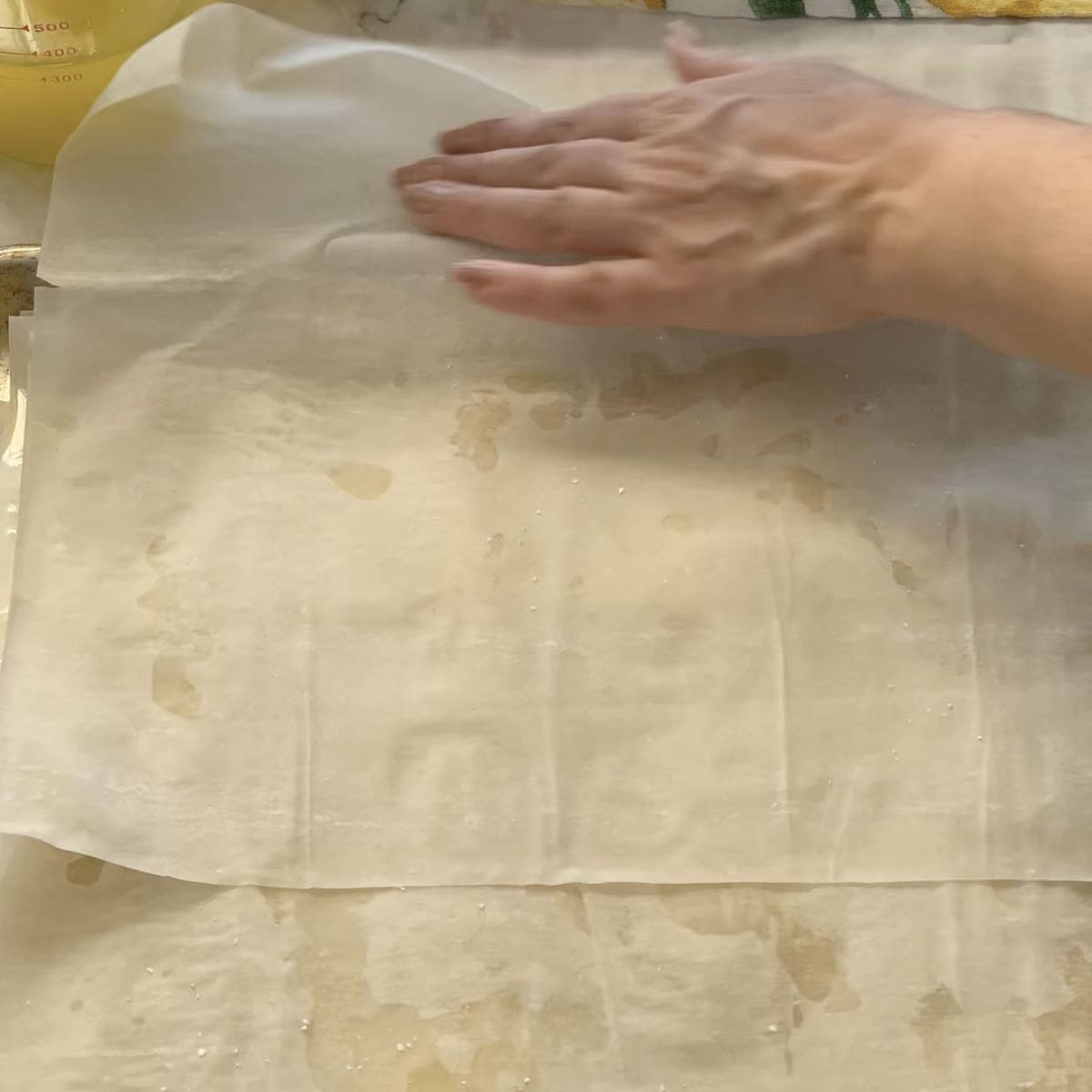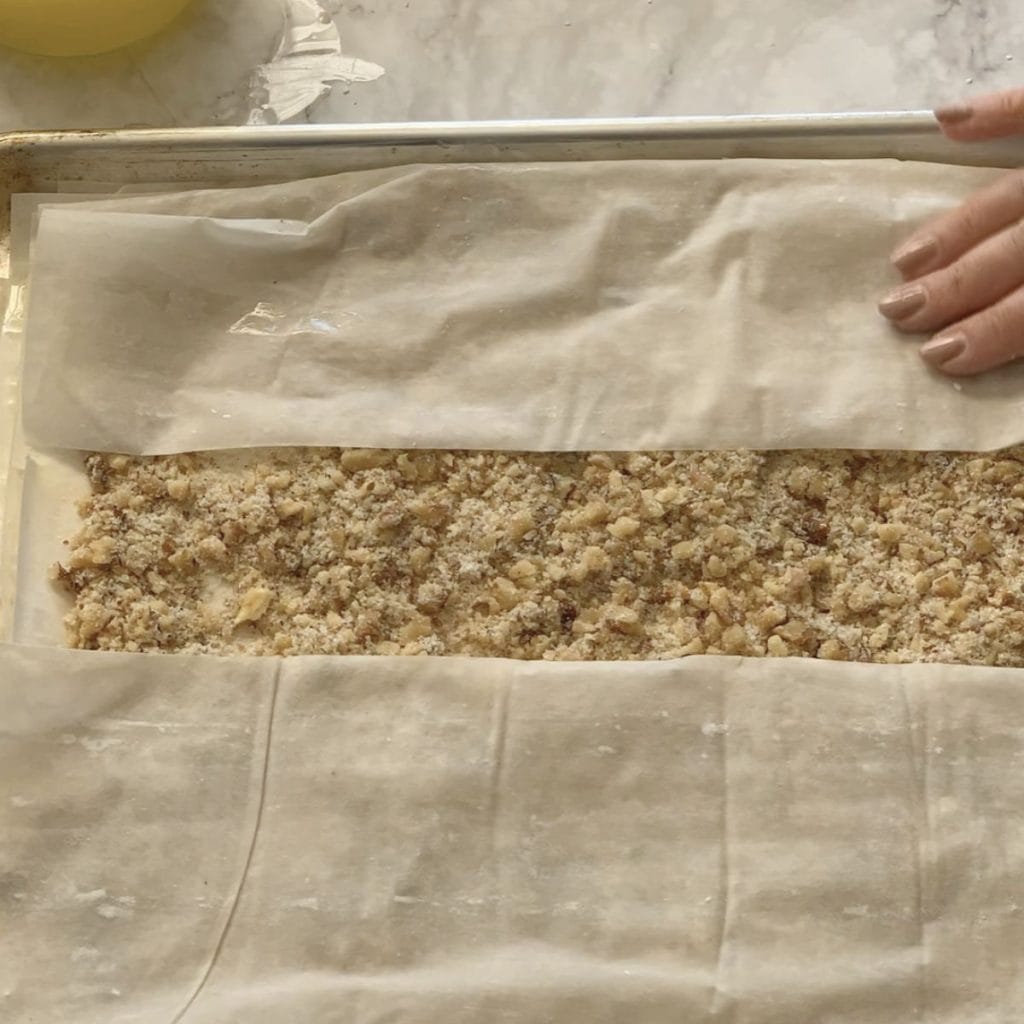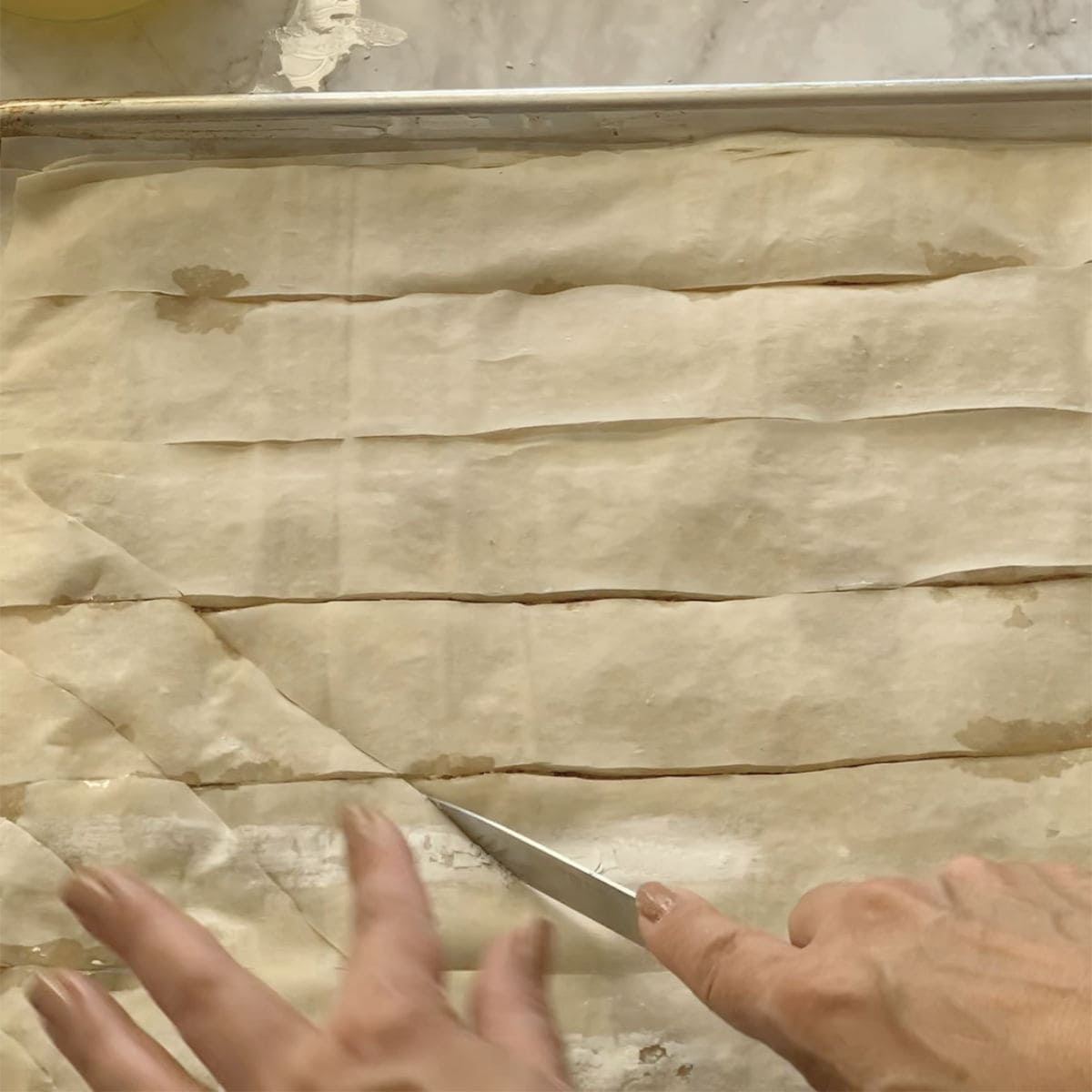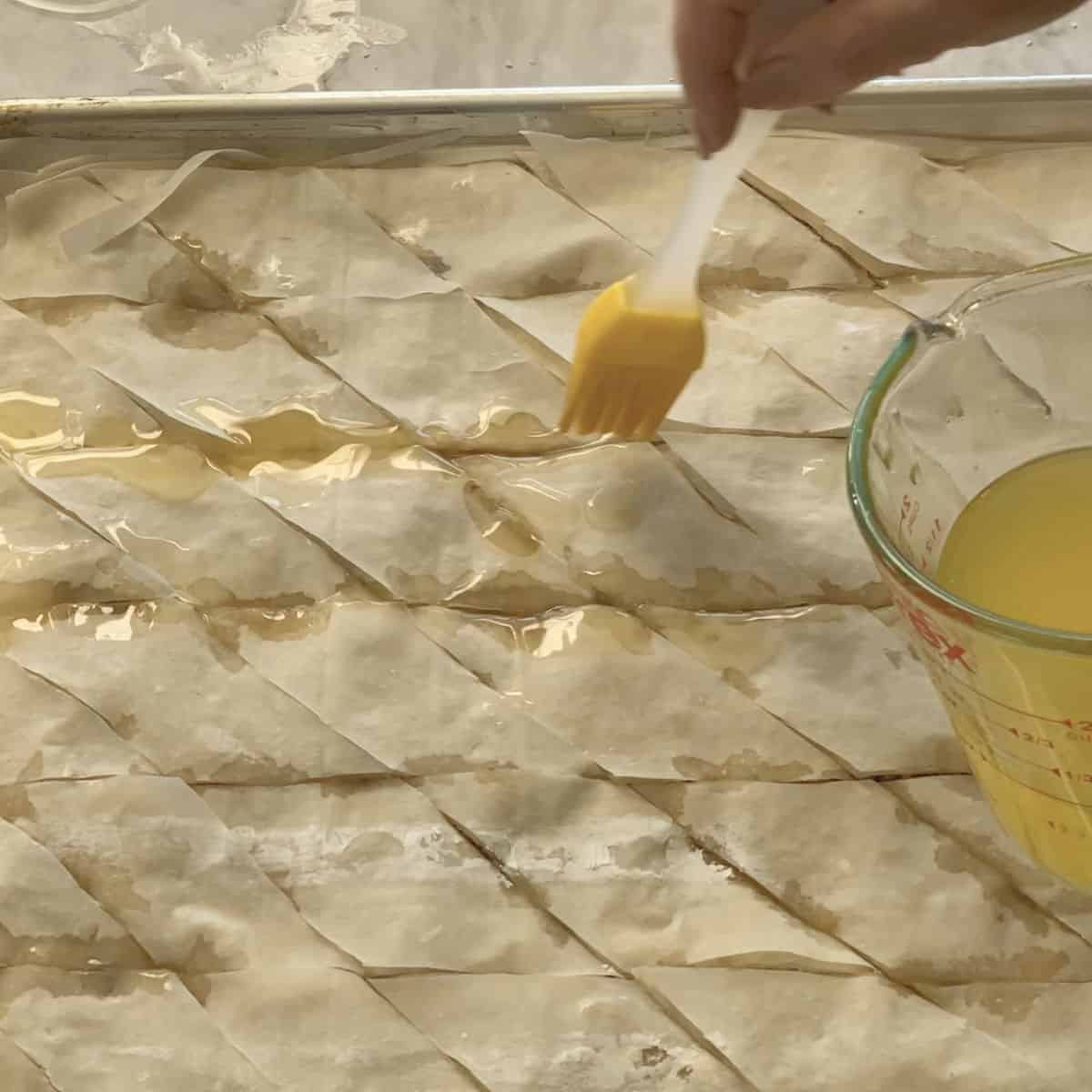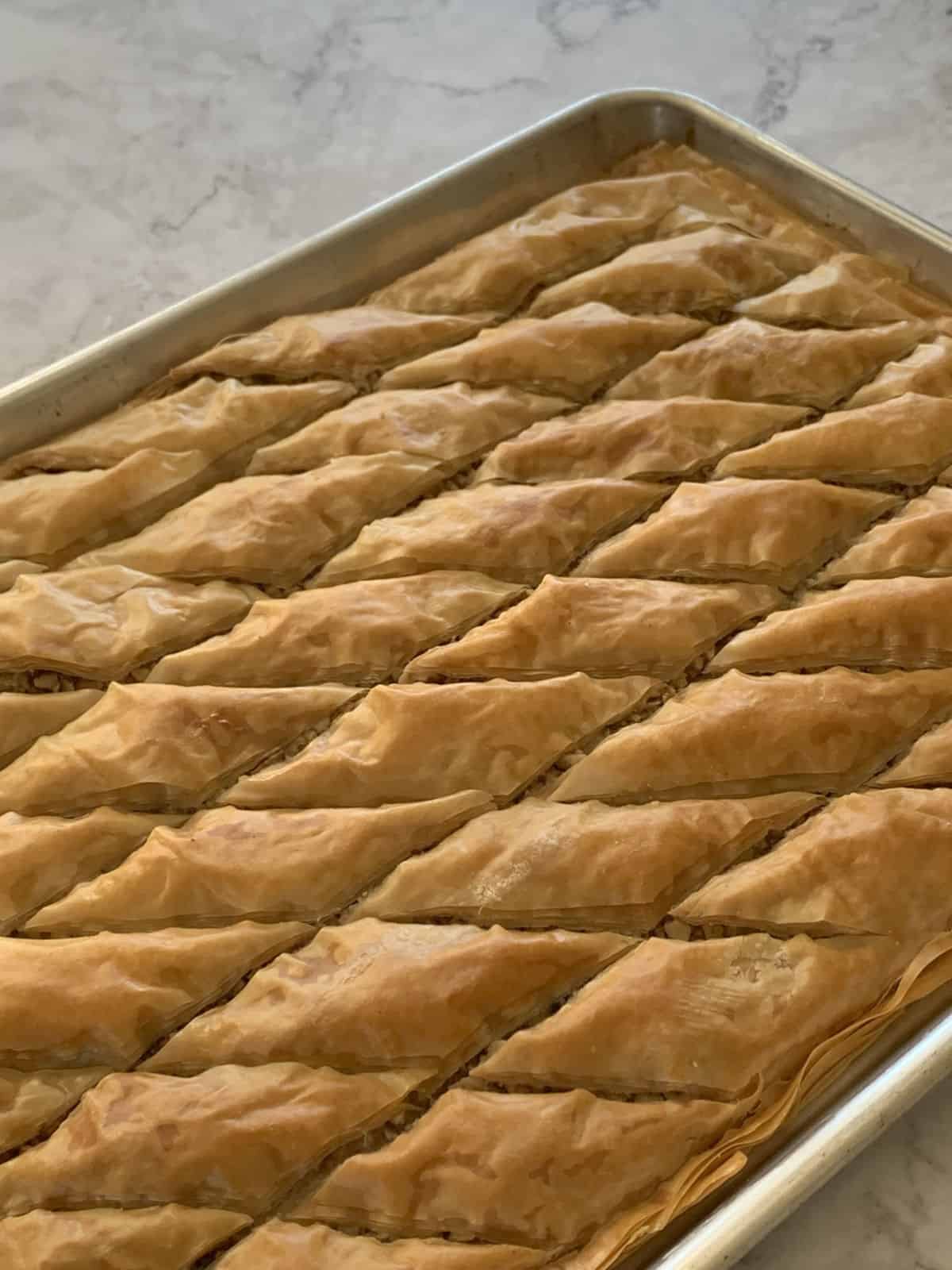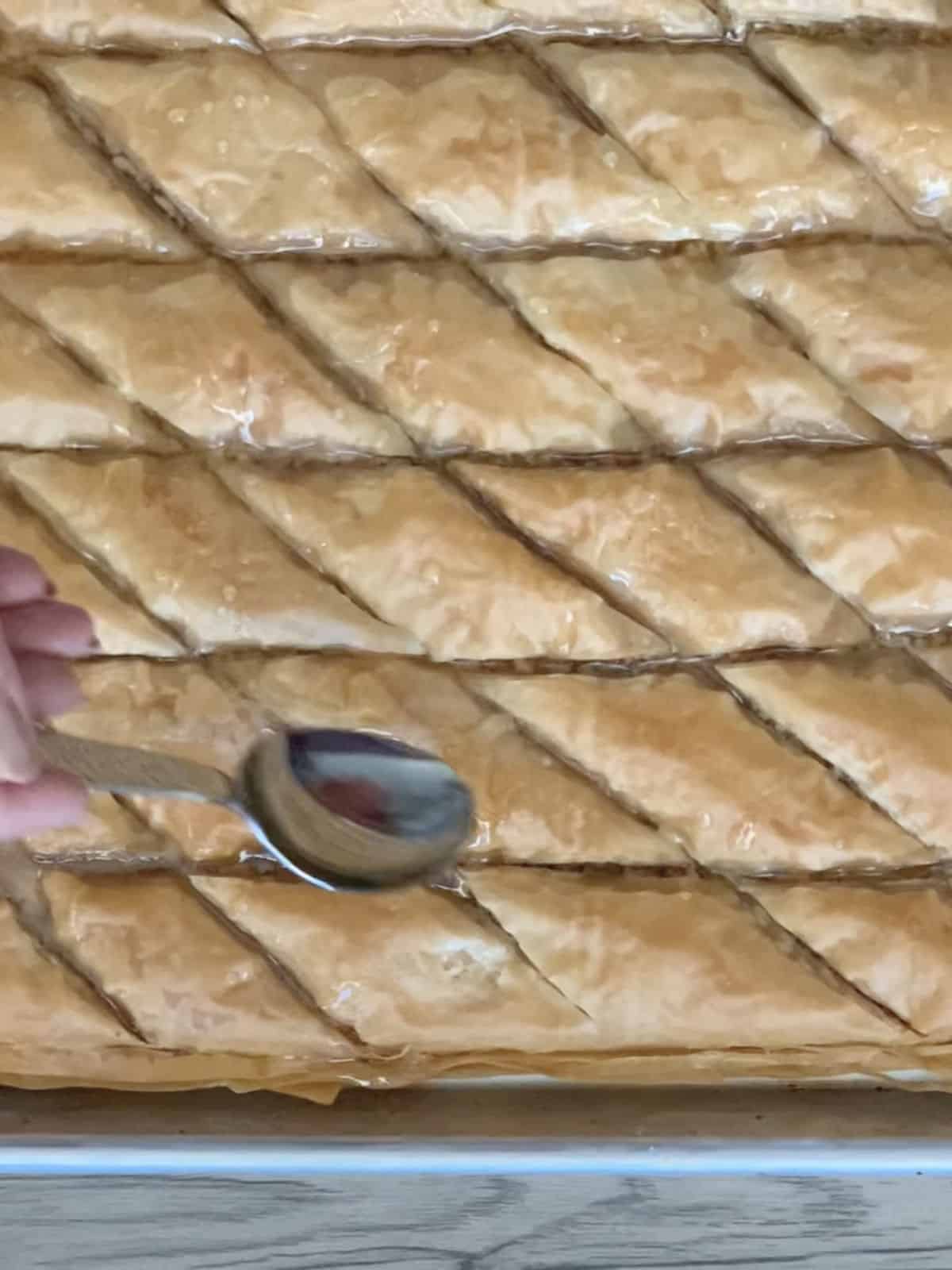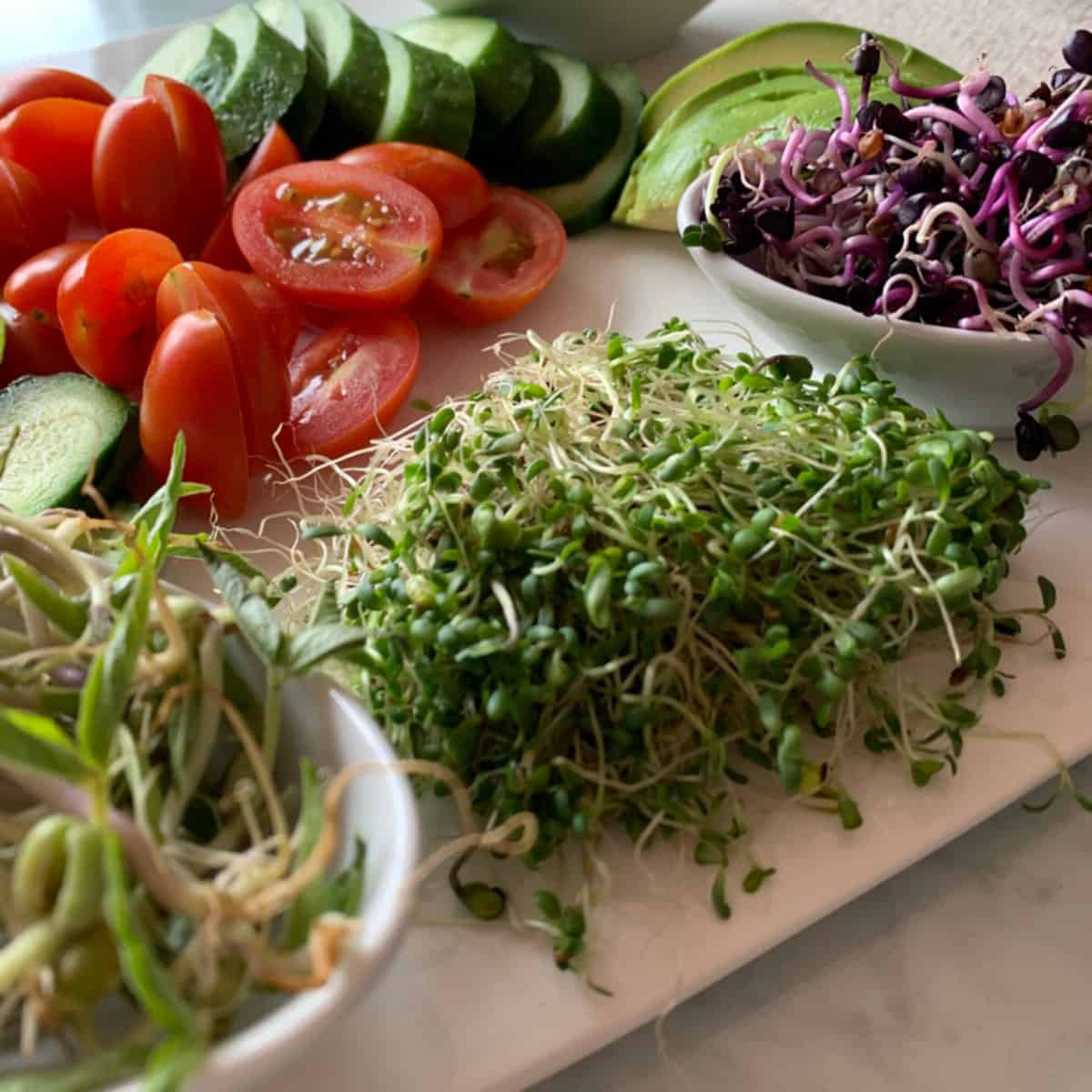Pakhlava Bliss – A Journey into the Sweet Layers of Tradition
A diamond-shaped parcel filled with layers of thin pastry sheets, packed with a nut mixture and liberally soaked in honey syrup. This gem of Armenian patisserie might sound like a challenging task, but I’ll guide you through the process of creating pakhlava and provide tips so you can create your own stunning confection.

Table of Contents
Chronicles of Tertanoush or Pakhlava
This intricate sweet nut filled pastry, referred to as tertanoush in Armenian tradition and recognized internationally as baklava or pakhlava, started its journey a long time ago.
Paklava is crafted by Armenians, Persians, Greeks, Arabs, at the crossroads where Europe, Asia, and Africa converge. As a culinary treasure, it’s influenced by and complements various traditions, reflecting a cultural tapestry in each layer. Each nation’s Paklava holds its unique flavor, aroma, and history where one can trace the culinary heritage that has evolved.
Atcharrian, a prominent scientist of linguistic, performed etymological research leading him to a 10th-century Ancient Armenian manuscript, where the term “tsagh” was mentioned; often synonymous with honeybread. He uncovered other references such as tsal-tsol (fold by fold) or tert-tert (sheet by sheet), indicative of dough layered with nuts, honey, and ghee across historical Armenian regions and dialects. This exploration pointed to the pastry’s origins as a honey-soaked delicacy.
The honey-infused paklava was a celebrated delicacy in Sebastia, Gamerek, Mush, Van, Tigranakert, Kesaria, Kars, Bayazet, and Erzrum; and was especially cherished during holidays and special events. Displaced, uprooted, and scattered all over the world, Armenians carry on the tradition of making, introducing, and sharing their beloved tertanoush.
From humble origins as a honey-soaked pastry to tertanoush, this dessert has become a cherished pastry, globally known as baklava.
What’s unique about this Recipe?
Grocery and Pantry List

Time Required:
Bake in a 350°F(180°C) preheated oven.
Special Tools to Use:
Recipe Steps at a Glance
This pakhlava recipe can be broken down into the following steps:
Step-by-step: How to Make Pakhlava
Step 1: Preparing walnut filling
In a food processor, pulse the nuts to achieve fine to medium-sized pieces, avoiding powder. Be mindful not to let the food processor run continuously. Add the sugar and spices, then pulse 2-3 times until fully combined. Transfer the mixture to a bowl, ready for use.
Step 2: Clarifying butter (creating ghee)
Melt the butter in a heavy-bottomed pan over medium heat, allowing it to gently simmer. Be attentive to prevent spillage. As the butter melts, it will foam up and rise. Sprinkle a tablespoon of flour; you’ll observe the foam clumping and settling. Reduce the heat, allowing it to cool a bit. Once cooled, you’ll see clarified butter on top and white milk solids at the bottom. Carefully pour through a fine mesh sieve into a glass jar, ensuring you don’t disturb the residue that’s on the bottom.
Step 3: Making syrup
Combine sugar with water and bring to a boil. Drop in the piece of lemon peel, and cloves if using. Cook for 10 minutes until syrup reaches 210 degrees F. Add the honey and lemon juice. Remove the lemon peel and cloves and set it aside to completely cool.
Step 4: Assembling the sheets
Open the phyllo dough package and lay it flat on a surface. Inspect the sheets, setting aside any broken ones. Reserve the best sheets for the top layer.
Pic 1: Layering phyllo sheets Pic 2: Pleating the phyllo sheets Pic 3: Overlapping the phyllo sheet
Begin layering the phyllo sheets immediately on the baking sheet. Using a pastry brush, apply a thin layer of clarified butter and place the second sheet on top.
Continue layering, applying butter between each sheet (pic 1). After the 4th layer, pleat 2-3 ‘not-so-perfect’ sheets into an accordion (pic 2) and lay them down. Brush with clarified butter and place the next sheet on top.
When halfway through the sheets (from your box), let the next two sheets overlap from the middle, overhanging on either side (pic 3).
Pic 4: Scattering the walnut filling Pic 5: Folding sheet back. Pic 6: Folding sheet back.
Scatter the walnut mixture in an even single layer (pic 4). Fold the overhanging flaps over, creating an envelope (pic 5 & 6), and continue the process of applying clarified butter and layering new sheets with the rest of the phyllo dough.
Step 5: Scoring the pakhlava
When it comes to scoring the pakhlava, there are different schools of thought—cutting it into squares, triangles, or the iconic diamond shape, which happens to be my preferred choice.
Pic 7: Scoring pakhlava vertically Pic 8: Scoring pakhlava diagonally. Pic 8: Scoring pakhlava diagonally.
To create a diamond pattern, the first cuts should be parallel to the sides of the sheet pan, while the cross cuts should be diagonal. The incisions should be about ⅔ deep, enough to cut through the walnut layer but not reach the bottom of the sheet.
Use a sharp knife with a vertical up-and-down cutting motion, as opposed to cut-and-drag technique.
First, score the edges all the way around. This will yield crisp looking edges for the final baked pakhlava.
Start by finding the center point of your sheet and make an incision all the way across. Then, divide each half into 3 and score those as well, resulting in 6 sections. Next, score one corner to make it into a triangle. Follow it up with another incision parallel to that one. This process creates a beautiful diamond pattern on your pakhlava.
Gently hold the phyllo sheet with your other hand to ensure they don’t lift.
After all the cuts are done, generously brush the seams with clarified butter (pic 10). Using the brush, iron out any layers that might have been shifted.
Your tray of pakhlava is ready for baking.
Step 6: Baking pakhlava and finishing
Preheat the oven to 350°F (180°C).
Position the baking tray in the middle rack and bake for 20 minutes. The pastry should visibly rise with a distinct diamond-shaped pattern.
Reduce the heat to 300°F (150°C) and continue baking for an additional 20 minutes.
Rotate the tray, increase the heat back to 350°F (180°C), and bake for an additional 10 minutes.
Remove the baked pakhlava from the oven (pic 11). With the sharp knife and go over the pre-cut groves and cut all the way through.
Pic 11: Baked pakhlava Pic 12: Spooning syrup over Pic 13: Spooning syrup over the cuts
Pour the cool down syrup over the hot pastry, ensue that all the pieces get a generous application of the syrup (pic 12 & 13).
Loosely cover with foil and let it all soak for at least 6-hours or overnight.
Best Way to Serve
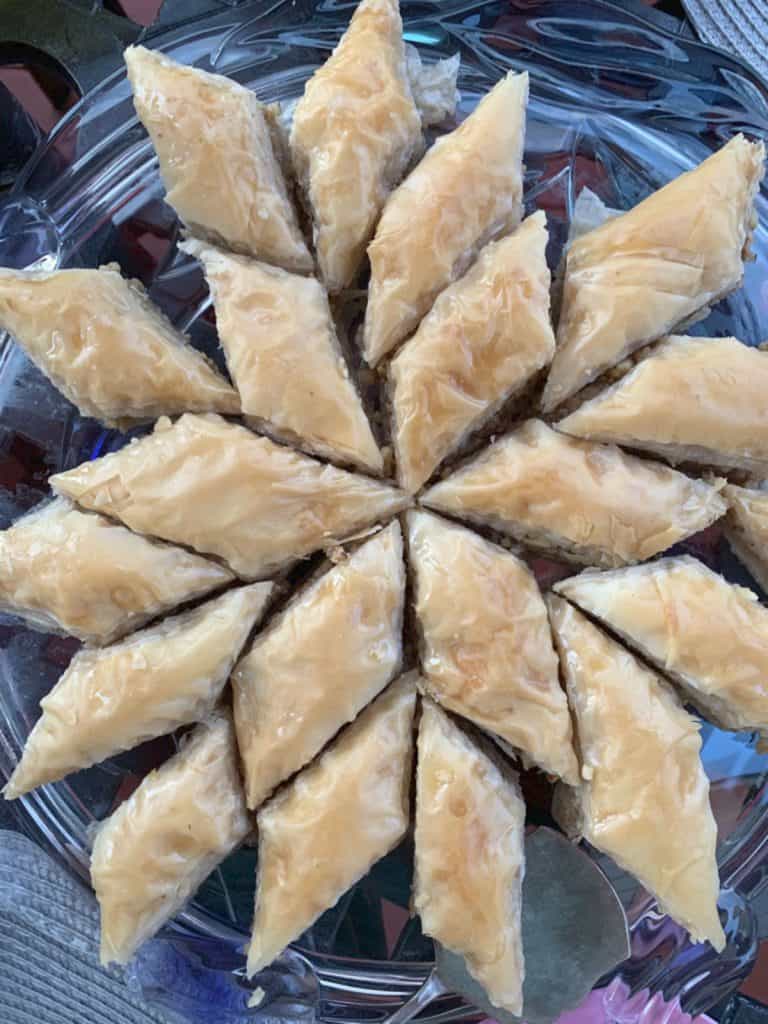
Tips and Wisdom from Cafe Osharak
Frequently Asked Questions
Does paklava store in the fridge?
The uniqueness of paklava is that it can stay at room temperate for weeks. The use of clarified butter and honey syrup, makes the pastry naturally preserved so it can stay out of the fridge.
Can you freeze paklava?
It freezes well and doesn’t lose its appeal or taste. Defrost in refrigerator or at room temperature. To spruce it up, make a small amount of simple syrup and pour the hot syrup over it.
Does paklava have honey?
Authentic paklava recipes always call for honey. If the honey is not an option, use all sugar, or agave nectar can be used (in place of honey).
More Recipes to Try From Cafe Osharak
If you try out this recipe, I would love to hear from you. Let me know if you find it delicious and straightforward to prepare. I am here to answer any questions and provide any suggestions. Also, be sure to explore other recipes from Cafe Osharak, as I’m sure you’ll love them too!
Pakhlava Bliss – A Journey into the Sweet Layers of Tradition

Ingredients
- 1 package phyllo dough 24-25 sheets
- 4 cups walnuts
- ¼ cup sugar
- 1/4 teaspoon cardamom seeds ground
- 2 cups ghee clarified butter
- 1 1/2 cups sugar
- 1 1/2 cups water
- 1 cup honey
- 1-2 tablespoon lemon juice
- Lemon peel
Instructions
Prepare the walnut filling
- In a food processor, chop the nuts with a few pulses. You want to have fine to medium pieces but not powder. Add the sugar and spices and give 2-3 pulses until fully combined. Transfer to a bowl until ready to use.4 cups walnuts, ¼ cup sugar, 1/4 teaspoon cardamom
Clarify the butter
- Melt the butter in a heavy-bottomed pan over medium heat, allowing it to gently simmer. Be attentive to prevent spillage. As the butter melts, it will foam and rise. Sprinkle a tablespoon of flour; you'll observe the foam clumping and settling.2 cups ghee
- Reduce the heat, allowing it to cool a bit. Once cooled, you'll see clarified butter on top and white milk solids at the bottom.
- Carefully pour through a fine mesh sieve into a glass jar, ensuring you don't disturb the residue that's on the bottom.
Start layering
- Open the phyllo dough package and lay it flat on a surface. Inspect the sheets, setting aside any broken ones. Reserve the best sheets for the top layer.1 package phyllo dough
- Begin layering the phyllo sheets immediately on the baking sheet. Using a pastry brush, apply a thin layer of clarified butter and place the second sheet on top.
- Continue layering, applying butter between each sheet. Brush with clarified butter and place the next sheet on top. When halfway through the sheets, let the next two sheets overlap from the middle, overhanging on either side.
- Scatter the walnut mixture in an even single layer. Fold the overhanging flaps over, creating an envelope, and continue the process of applying clarified butter and layering the sheets.
Scoring the paklava
- When it comes to scoring the paklava, there are different schools of thought: cutting it into squares, triangles, or the iconic diamond shape, which happens to be my preferred choice.
- To create a diamond pattern, the first cuts should be parallel to the sides of the sheet pan, while the cross cuts should be diagonal. The incisions should be about ⅔ deep, enough to cut through the walnut layer but not reach the bottom of the sheet.
- Use a sharp knife with a vertical up-and-down cutting motion, as opposed to the cut-and-drag technique.
- First, score the edges all the way around. This will give crisp looking edges to the final baked paklava.
- Start by finding the center point of your sheet and make an incision all the way across. Then, divide each half into 3 and score those as well, resulting in 6 sections.
- Next, score one corner to make it into a triangle. Follow it up with another incision parallel to that one. This process creates a beautiful diamond pattern on your paklava.
- Gently hold the phyllo sheet with your other hand to ensure they don’t lift.
- After all the cuts are done, generously brush the seams with clarified butter. Using the brush, iron out any layers that might have been shifted.
Baking pakhlava
- Preheat the oven to 350°F (180°C).
- Position the baking tray in the middle rack and bake for 20 minutes. The pastry should visibly rise with a distinct diamond-shaped pattern.
- Reduce the heat to 300°F (150°C) and continue baking for an additional 20 minutes.
- Rotate the tray, increase the heat back to 350°F (180°C), and bake for an additional 10 minutes.
- Pull the baked pastry and finish by cutting the pieces through.
Making syrup
- Combine sugar with water and bring it to a boil. Drop the piece of lemon peel, and cloves if using. Cook for 10 minutes until syrup reaches 210 degrees F. Add the honey and lemon juice. Remove the lemon peel and cloves and set it aside.1 1/2 cups sugar, 1 1/2 cups water, 1 cup honey, 1-2 tablespoon lemon juice, Lemon peel
